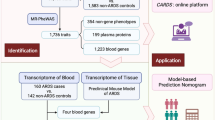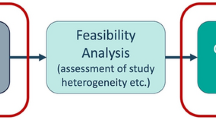Abstract
Multiple transcription factors (TFs) coordinately control transcriptional regulation of genes in eukaryotes. Although numerous computational methods focus on the identification of individual TF-binding sites (TFBSs), very few consider the interdependence among these sites. In this article, we studied the relationship between TFBSs and microarray gene expression levels using both family-wise and member-specific motifs, under various combination of regression models with Bayesian variable selection, as well as motif scoring and sharing conditions, in order to account for the coordination complexity of transcription regulation. We proposed a three-step approach to model the relationship. In the first step, we preprocessed microarray data and usedp-values and expression ratios to preselect upregulated and down-regulated genes. The second step aimed to identify and score individual TFBSs within DNA sequence of each gene. A method based on the degree of similarity and the number of TFBSs was employed to calculate the score of each TFBS in each gene sequence. In the last step, linear regression and probit regression were used to build a predictive model of gene expression outcomes using these TFBSs as predictors. Given a certain number of predictors to be used, a full search of all possible predictor sets is usually combinatorially prohibitive. Therefore, this article considered the Bayesian variable selection for prediction using either of the regression models. The Bayesian variable selection applied in the context of gene selection, missing value estimation, and regulatory motif identification. In our modeling, the regressor was approximated as a linear combination of the TFBSs and a Gibbs sampler was employed to find the strongest TFBSs. We applied these regression models with the Bayesian variable selection on spinal cord injury gene expression data set. These TFs demonstrated intricate regulatory roles either as a family or as individual members in neuroinflammatory events. Our an alysis can be applied to create plausible hypotheses for combinatorial regulation by TFBSs and avoiding false-positive candidates in the modeling process at the same time. Such a systematic approach provides the possibility to dissect transcription regulation, from a more comprehensive perspective, through which phenotypical events at cellular and tissue levels are moved forward by molecular events at gene transcription and translation levels.
Similar content being viewed by others
References
Albert, J. and Chib, S. (1993) Bayesian analysis of binary and polychotomous response data. J. Am. Stat. Assoc. 88, 669–679.
Azizkhan, J. C., Jensen, D. E., Pierce, A. J., and Wade, M. (1993) Transcription from TATA-less promoters: dihydrofolate reductase as a model. Crit. Rev. Eukaryot. Gene Expr. 3, 229–254.
Bailey, T. L. and Elkan, C. (1994) Fitting a mixture model by expectation maximization to discover motifs in biopolymers. Proc. Int. Conf. Intell. Syst. Mol. Biol. 2, 28–36.
Bailey, T. L. and Noble, W. S. (2003) Searching for statistically significant regulatory modules. Bioinformatics. 19(Suppl 2), II16-II25.
Bigger, C. B., Melnikova, I. N., and Gardner, P. D. (1997) Sp1 and Sp3 regulate expression of the neuronal nicotinic acetylcholine receptor beta4 subunit gene. J. Biol. Chem. 272, 25,976–25,982.
Birnbaum M. J., van Wijnen, A. J., Odgren, P. R., et al. (1995) Sp1 trans-activation of cell cycle regulated promoters is selectively repressed by Sp3. Biochemistry 34, 16,503–16,508.
Bussemaker, H. J., Li, H., and Siggia, E. D. (2001) Regulatory element detection using correlation with expression. Nat. Genet. 27, 167–171.
Chen, Q. K., Hertz, G. Z., and Stormo, G. D. (1995) MATRIX SEARCH 1.0: A computer program that scans DNA sequences for transcriptional elements using a database of weight matrices. Comput. Appl. Biosci. 11, 563–566.
Conlon, E. M., Liu, X. S., Lieb J. D., and Liu, J. S. (2003) Integrating regulatory motif discovery and genome-wide expression analysis. Proc. Natl. Acad. Sci. USA. 100, 3339–3344.
Ensemble (2004) Project Ensemble (http://www. ensembl.org/).
Geiger, A., Salazar, G., and Kervran, A. (2001) Role of the Sp family of transcription factors on glucagon receptor gene expression. Biochem. Biophys. Res. Commun. 285, 838–844.
Grabe, N. (2002) AnBaba2: Context specific identification of transcription factor binding sites. In Silico Biol. 2, S1-S15.
Grundy, W. N., Bailey, T. L., Elkan, C. P., and Baker, M. E. (1997) Meta-MEME: motif-based hidden Markov models of protein families. Comput. Appl. Biosci. 13, 397–406.
Hagen, G., Muller, S., Beato, M., and Suske, G. (1994) Sp1-mediated transcriptional activation is repressed by Sp3. EMBO J. 13, 3843–3851.
Imai, K. and van Dyk, D. A. (2003) A Bayesian analysis of the multinomial probit model using marginal data augmentation. J. Econometrics 124, 311–334.
Kechris, K. J., van Zwet, E., Bickel, P. J., and Eisen, M. B. (2004) Detecting DNA regulatory motifs by incorporating positional trends in information content. Genome Biol 5, R50.
Kel, A. E., Gossling, E., Reuter, I., Cheremushkin, E., Kel-Margoulis, O. V., and Wingender, E. (2003) MATCH: A tool for searching transcription factor binding sites in DNA sequences. Nucl. Acids Res. 31, 3576–3579.
Kel, A., Kel-Margoulis, O., Babenko, V., and Wingender, E. (1999) Recognition of NFATp/ AP-1 composite elements within genes induced upon the activation of immune cells. J. Mol. Biol. 288, 353–376.
Keles, S., van der Laan, M., and Eisen, M. B. (2002) Identification of regulatory elements using a feature selection method. Bioinformatics 18, 1167–1175.
Keles, S., van der Laan, M. J., and Vulpe C. (2004) Regulatory motif finding by logic regression. Bioinformatics 20, 2799–2811.
Lee, K. E., Sha, N., Dougherty, E. R., Vannucci, M., and Mallick, B. K. (2003) Gene selection: a Bayesian variable selection approach. Bioinformatics 19, 90–97.
Liu, X. S., Brutlag, D. L., and Liu, J. S. (2002) An algorithm for finding protein-DNA binding sites with applications to chromatin-immunoprecipitation microarray experiments. Nat. Biotechnol. 20, 835–839.
Majello, B., De Luca, P., and Lania, L. (1997) Sp3 is a bifunctional transcription regulator with modular independent activation and repression domains. J. Biol. Chem. 272, 4021–4026.
Matys, V., Fricke, E., Geffers, R., et al. (2003) TRANSFAC: transcriptional regulation, from patterns to profiles. Nucl. Acids Res. 31, 374–378.
NCBI (2004) National Center for Biotechnology Information (http://www.ncbi.nlm.nih.gov/).
Noti, J. D. (1997) Sp3 mediates transcriptional activation of the leukocyte integrin genes CD11C and CD11B and cooperates with c-Jun to activate CD11C. J. Biol. Chem. 272, 24,038–24,045.
Pan, J. Z., Jornsten, R., and Hart, R. P. (2004) Screening anti-inflammatory compounds in injured spinal cord with microarrays: A comparison of bioinformatics analysis approaches. Physiol. Genom. 17, 201–214.
Popovich, P. G. and Jones, T. B. (2003) Manipulating neuroinflammatory reactions in the injured spinal cord: back to basics. Trends Pharmacol. Sci. 24, 13–17.
Prestridge, D. S. (1996) SIGNALSCAN 4.0: Additional databases and sequence formats. Comput. Appl. Biosci. 12, 157–160.
Quandt, K., Frech, K., Karas, H., Wingender, E., and Werner, T. (1995) MatInd and MatInspector: New fast and versatile tools for detection of consensus matches in nucleotide sequence data. Nucl. Acids Res. 23, 4878–4884.
Rajakumar, R. A., Thamotharan, S., Menon, R. K. and Devaskar, S. U. (1998) Sp1 and Sp3 regulate transcriptional activity of the facilitative glucose transporter isoform-3 gene in mammalian neuro-blasts and trophoblasts. J. Biol. Chem. 273, 27,474–27,483.
Rajakumar, R. A., Thamotharan, S., Raychaudhuri, N., Menon, R. K., and Devaskar, S. U. (2004) Trans-activators regulating neuronal glucose transporter isoform-3 gene expression in mammalian neurons. J. Biol. Chem. 279, 26,768–26,779.
RGSC (2004) Rat Genome Sequencing Consortium (http://www.hgsc.bcm.tmc.edu/projects/rat/ assembly.html).
Robert, C. (1995) Simulation of truncated normal variables. Stat. Comput. 5, 121–125.
Ross, S., Tienhaara, A., Lee, M. S., Tsai, L. H., and Gill, G. (2002) GC box-binding transcription factors control the neuronal specific transcription of the cyclin-dependent kinase 5 regulator p35. J. Biol. Chem. 277, 4455–4464.
Smith, M. and Kohn, R. (1997) Nonparametric regression using Bayesian variable selection. J. Econometry 75, 317–344.
Supp, D. M., Witte, D. P., Branford, W. W., Smith, E. P., and Potter, S. S. (1996) Sp4, a member of the Sp1-family of zinc finger transcription factors, is required for normal murine growth, viability, and male fertility. Dev. Biol. 176, 284–299.
Tadesse, M. G., Vannucci, M., and Lio, P. (2004) Identification of DNA regulatory motifs using Bayesian variable selection. Bioinformatics 20, 2553–2561.
Tompa, M., Li, N., Bailey, T. L., et al. (2005) Assessing computational tools for the discovery of transcription factor binding sites. Nat. Biotechnol. 23, 137–144.
Troyanskaya, O., Cantor, M., Sherlock, G., et al. (2001) Missing value estimation methods for DNA microarrays. Bioinformatics 17, 520–525.
van Helden, J., Andre, B., and Collado-Vides, J. (1998) Extracting regulatory sites from the upstream region of yeast genes by computational analysis of oligonucleotide frequencies. J. Mol. Biol. 281, 827–842.
Yoo, J., Jeong, M. J., Kwon, B. M., Hur, M. W., Park, Y. M., and Han, M. Y. (2002) Activation of dynamin I gene expression by Sp1 and Sp3 is required for neuronal differentiation of N1E-115 cells. J. Biol. Chem. 277, 11,904–11,909.
Zhou, X., Wang, X., and Dougherty, E. R. (2003a) Binarization of microarray data based on a mixture model. Mol. Cancer Ther. 2, 679–684.
Zhou, X., Wang, X., and Dougherty, E. R. (2003b) Missing-value estimation using linear and nonlinear regression with Bayesian gene selection, Bioinformatics 19, 2302–2307.
Zhou, X., Wang, X., and Dougherty, E. R. (2004) Gene prediction using multinomial probit regression with the Bayesian variable selection. EURASIP J. Appl. Signal Proc. 3, 115–124.
Author information
Authors and Affiliations
Corresponding author
Rights and permissions
About this article
Cite this article
Liu, KY., Zhou, X., Kan, K. et al. Bayesian variable selection for gene expression modeling with regulatory motif binding sites in neuroinflammatory events. Neuroinform 4, 95–117 (2006). https://doi.org/10.1385/NI:4:1:95
Issue Date:
DOI: https://doi.org/10.1385/NI:4:1:95




